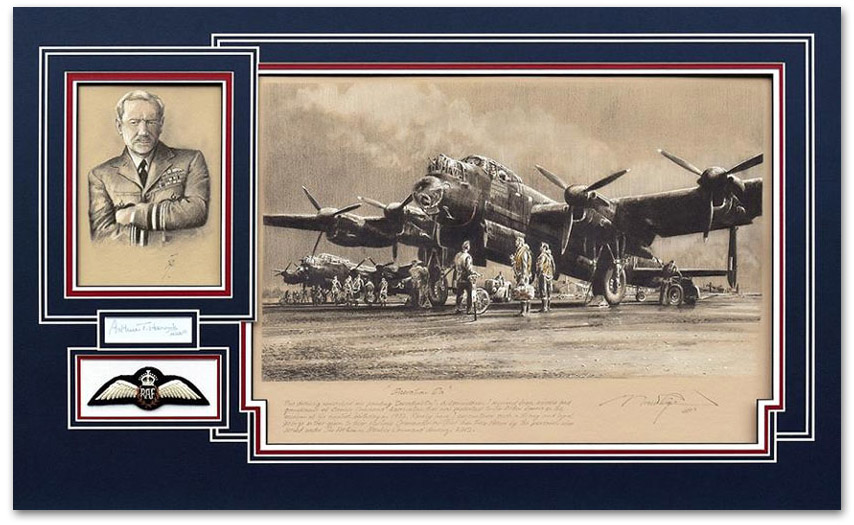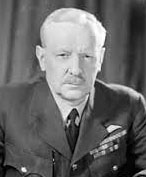

Sir Arthur Harris
by Robert Taylor
In February 1942 Air Marshal Arthur ‘Bomber’ Harris was appointed the new Air Officer
Commanding-in-Chief Bomber Command. Determined, single-minded, the current commander
of 5 Group and a veteran airman who’d led a front-line squadron in the First World War, Harris’
task was to inject a new impetus into a bomber offensive that would shatter German industry -
and morale. If he could achieve his objectives, Harris would ultimately become the architect and
mastermind behind the RAF’s successful strategic bombing offensive against Germany. This stunning new drawing echoes the famous painting originally commissioned and presented to
Sir Arthur at the Bomber Command Reunion in 1982. Matted alongside is a separate matching-numbered piece – a portrait of the famous
man himself specially created by Robert for the occasion. Both drawings have been meticulously created as Giclée proofs by one of the top English master
print-makers and reproduced on museum quality archival papers. |
| Overall matted size: 20¼" x 33" | Available in the following editions |
| 25 | Limited edition | Two giclee proof prints matted with the signature of Sir Arthur Harris. | $2195 |
| Overseas orders: Due to the packaging required to ship this piece, additional shipping costs apply to deliveries outside the U.S.. |
 |
Only 25 of this memorable edition are available worldwide. Each pair of drawings is professionally matted to full conservation standards in a single composition that includes museum-quality reproduction RAF King’s Crown Wings and an original and fully authenticated autograph of To complete the portfolio, accompanying the matted compilation is a copy of a matching-numbered book ‘The Avro Lancaster in Air Combat Paintings” by Robert Taylor’, specially written and created for this release. |
Born in Gloucestershire on 13th April 1892, Harris emigrated to Rhodesia in 1910, aged 17. He joined the 1st Rhodesia Regiment at the outbreak of the First World War and saw action in South Africa and South West Africa. In 1915, Harris returned to England to fight in the European theatre of the war joining the Royal Flying Corps, with which he remained until the formation of the Royal Air Force in 1918. Harris remained in the Air Force through the 1920s and 1930s, serving in India, Mesopotamia, Persia, Egypt, Palestine, and elsewhere. At the outbreak of the Second World War in 1939, Harris took command of No. 5 Group RAF in England, and in February 1942 was appointed head of Bomber Command. He retained that position for the rest of the war. In the same year, the British Cabinet agreed to the ‘area bombing’ of German cities. Harris was given the task of implementing Churchill's policy and supported the development of tactics and technology to perform the task more effectively. Harris assisted British Chief of the Air Staff Marshal of the Royal Air Force Charles Portal in carrying out the United Kingdom's most devastating attacks against the German infrastructure and population, including the Bombing of Dresden. Harris' role in the RAF's campaign against the German war machine cannot be underestimated, without him the outcome may have been quite different. After the war Harris moved to South Africa, where he managed the South African Marine Corporation. He was created a baronet in 1953 and died on 5th April 1984. |
| Receive your print fully framed and ready to display. Please call or email us for a custom framing quote. |
 Marshal of the Royal Air Force Sir Arthur Travers Harris, 1st Baronet, GCB, OBE, AFC
commonly known as "Bomber" Harris by the press and often within the RAF as "Butcher"
Harris, was Air Officer Commanding-in-Chief RAF Bomber Command during the height of the
strategic bombing campaign against Nazi Germany in the Second World War.
Marshal of the Royal Air Force Sir Arthur Travers Harris, 1st Baronet, GCB, OBE, AFC
commonly known as "Bomber" Harris by the press and often within the RAF as "Butcher"
Harris, was Air Officer Commanding-in-Chief RAF Bomber Command during the height of the
strategic bombing campaign against Nazi Germany in the Second World War.